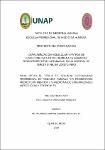Caracterización molecular y patrón de susceptibilidad antimicrobiana en gérmenes productores de b-Lactamasas, en un hospital de tercer nivel en Loreto, Perú
Abstract
An increase in infections caused by extended-spectrum beta-lactamaseproducing gram-negative bacilli (ESBL) represents a growing problem worldwide. Several studies conducted at the Regional Hospital of Loreto have reported up to 50% prevalence of infections associated with ESBL bacteria. We are currently experiencing a major epidemic of these ESBL-producing gramnegative germs (CTX-M15, SHV, TEM) that emerged from the hospital environment a few years ago and has even migrated to the community environment due to the indiscriminate use of antibiotics. The objective of the study is to identify the phenotypic and molecular character of resistance associated with these infections. Using a descriptive design, the proposed study will describe, using molecular biology techniques, the phenotypic and genotypic characteristics of these beta-lactamase-producing agents. The methodology consists of identifying all the positive cultures of patients hospitalized in the Regional Hospital of Loreto, to whom, using an automated system of "VITEK-2", the bacterial identification and antibiotic susceptibility (phenotype) for E. coli and Klebsiella spp will be carried out. . All cultures belonging to patients who meet the proposed criteria will be included in the study. All cultures with a phenotypic character with ESBL production will have the DNA of the resistance genes extracted and the amplification and naming of the molecular pattern will be carried out in order to determine the genotypic characteristics of the multi-resistant agents in our environment. The information obtained from this study is very important in daily medical practice because it will provide clinical and bacteriological criteria that will allow anticipating which patients could have an unfavorable evolution or risk of mortality and also have evidence for the rational use of antibiotics. Un incremento de las infecciones causadas por bacilos gram negativos productores de betalactamasas de espectro extendido (BLEE) representa un problema creciente a nivel mundial. Varios estudios realizados en el Hospital Regional de Loreto han reportado hasta 50% de prevalencia de infecciones asociadas a bacterias BLEE. Actualmente cursamos con una gran epidemia de estos gérmenes gram negativos productores de BLEE (CTX-M15, SHV, TEM) que partieron del ambiente hospitalario hace algunos años y que ha migrado incluso al ambiente comunitario debido al uso indiscriminado de antibióticos. El objetivo del estudio es identificar el carácter fenotípico y molecular de resistencia asociada a estas infecciones. Utilizando un diseño descriptivo, el estudio propuesto describirá utilizando técnicas de biología molecular las características fenotípicas y genotípicas de estos agentes productores de betalactamasas. La metodología consiste en identificar todos los cultivos positivos de pacientes hospitalizados en el Hospital Regional de Loreto, a los cuales utilizando un sistema automatizado de “VITEK-2” se realizará la identificación bacteriana y susceptibilidad antibiótica(fenotipo) para E. coli y Klebsiella spp. Serán incluidos en el estudio todos los cultivos que pertenezcan a pacientes que reúnan los criterios propuestos. A todos los cultivos con carácter fenotípico con producción de BLEE se les extraerá el ADN de los genes de resistencia y se realizará la amplificación y denominación del patrón molecular con el fin de determinar las características genotípicas de los agentes multi-resistentes en nuestro medio. La información obtenida del presente estudio es muy importante en la práctica médica diaria porque permitirá tener criterios clínicos y bacteriológicos que permitirán anticipar cuales pacientes se podrían tener una evolución de desfavorable o riesgo de mortalidad yasimismo tener evidencias para el uso racional de los antibióticos.


